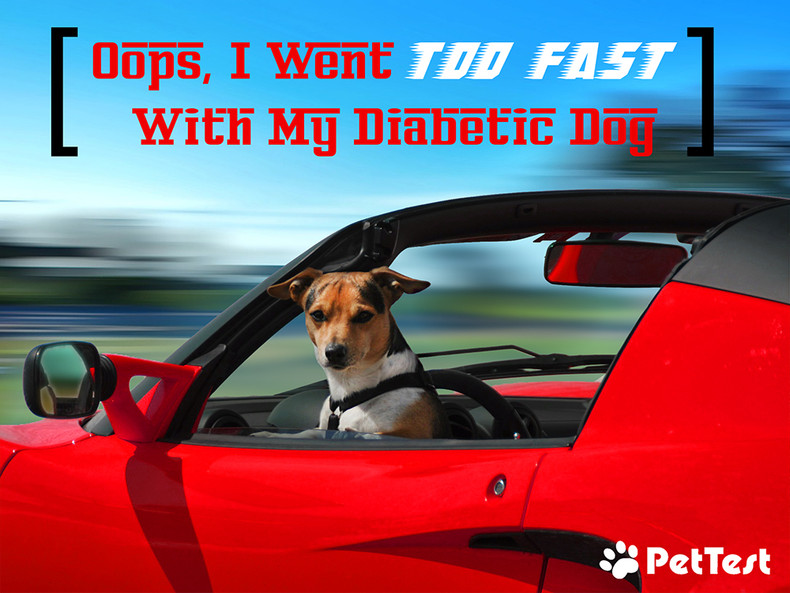Oops, I Went Too Fast With My Diabetic Dog
Today we talk about what happens when you increase your insulin too fast. Yup, the dreaded rebound also known as Somogyi Effect. I have touched on this in a prior post that you can read here. Today we take a deeper dive into the physiological aspects of rebound. I will do my best to make it easy to understand so that you can recognize it if it happens but most of all to avoid it because we are impatient and want to see better results faster. In the last two posts I talked about curves and that has brought us to recognizing rebound in the curves that you do. I encourage you to get familiar with this phenomenon so that if you see evidence of it in a curve that you have done or that your vet has done, you can deal with it immediately.
If you don’t curve at home, which I truly hope that you do, and take your pup to your vet for curves, please, please; please get the numbers for your files! I’m sad to say that many vets don’t believe that rebound is real so recognizing it will fall to you. And correcting it will likely fall to you also. Let’s start with this question, what is Rebound?
In short rebound is too much insulin. According to Merck, the maker of Vetsulin, “An insulin dose that is too high may bring about the Somogyi effect or rebound hyperglycemia. This is produced because blood glucose concentrations fall too rapidly. The moment that the Somogyi effect is triggered is very individual – it is a life-saving response.”
Here’s what happens when too much insulin is given:
- BG (Blood Glucose) falls quickly and approaches hypoglycemia (a BG of less than 65) following the injection of insulin. The pup becomes hungry, restless or in some cases lethargic or there can be no outward indicators at all.
- In response to the declining BG (Blood Glucose) in the central nervous system the body releases these hormones: epinephrine which turns to cortisol, glucagon and growth hormone.
- Those hormones raise BG (Blood Glucose) quickly to save the pup.
- The rapid increase in BG (Blood Glucose) from the release of the hormones can manifest in increased thirst and urination which are symptoms of not enough insulin and the misreading of those symptoms will make the issue even worse.
If the signs of Somogyi are misinterpreted, and the insulin dose is raised, the problem will be aggravated and an even more pronounced Somogyi effect will follow. Eventually the body’s ability to release hormones to save itself may be exhausted and a severe hypoglycemic event can occur. The hyperglycemia from a “rebound event” can last for 3 days resulting in high numbers even though the insulin dose has been lowered. Patience is key in this situation.
How do we recognize rebound from a curve? You may see any one of the following scenarios
- A low nadir (insulin peak) followed by a “rebound” of hyperglycemia (high BG number).
- A rapid decrease in BG (Blood Glucose) shortly after insulin is given followed by a rebound hyperglycemia.
- A high numbered flat curve with little to no movement in the BG (Blood Glucose) numbers.
- With an increase of insulin dose, the numbers go even higher.
Merck, the maker of Vetsulin suggests that the way to break the rebound cycle is to decrease the insulin dose by 50% or to return to the starting dose, whichever is lower. Keep in mind that you will see numbers bounce around while breaking the rebound cycle for up to 3 days on average. Every dog is different so some may break the cycle with the first dose of the decreased insulin; others may bounce around for more than 3 days.
You can see that Somogyi is not a pleasant event and should be avoided at all costs if at all possible. As it turns out it is possible to avoid it if you go slow and steady throughout the “regulation process”. By that I mean you need to let each insulin dose settle fully while you are trying to find your perfect dose. Increasing insulin in large increments makes it all too likely that you will miss your perfect dose and rebound can occur. Increasing insulin too often without allowing the prior increase to settle fully is also asking for trouble.
In short, when early in your diagnosis, have patience, increase your insulin doses in appropriate increments (1 unit at a time for large dogs and ½ unit at a time in small dogs as a rule) and allow those increases to settle for a full week.
Notice that for most of the products or groups that I mention, the text is linked to a website that you can purchase that item or a link to join the group mentioned. Just click on the colored text (red or blue, depending what device you are on) and it should take you right to the item or group. If you have any thoughts or ideas for topics that you’d like to see covered here, please feel free to comment below or send me an email at NancyForPetTest@PharmaSupply.com. As always, please “like” this blog post or any of the others that have helped you or just refreshed your memory. Look for new posts every Monday, Wednesday and Friday!
Until next time…

